Optimizing Simulation and Analysis of Automated Top-Coal Drawing Technique in Extra-Thick Coal Seams
Abstract
1. Introduction
2. Numerical Approach for Modeling Top-Coal Drawing
2.1. Theories of Particle Element in CDEM
2.2. Theoretical Model of Top-Coal Drawing
2.2.1. The Hypotheses of the Bergmark-Roos Model
- (1)
- Fragments move along straight lines from their initial location points to drawing opening, and then are removed continuously from model.
- (2)
- Fragments are only controlled by gravity and frictional forces between fragments.
- (3)
- The acceleration of each fragment is constant during the whole moving process.
2.2.2. Top-Coal Motion Equations
3. Numerical Model and Simulation Scheme
3.1. Numerical Model
3.2. Simulation Scheme
4. Numerical Simulation Results
4.1. Verification of Numerical Approach
4.2. Effect of Top-Coal Thickness
4.3. Optimizing of Automated Top-Coal CavingTtechnology
4.3.1. Automated Top-Coal Caving Time
4.3.2. Automated One-round Coal Drawing
4.3.3. Automated Three-round Coal Drawing
4.3.4. Automated Three-Round Equal Time Coal Drawing
4.3.5. Automated Three-Round Unequal Time Coal Drawing
5. Discussion
5.1. Different Top-Coal Caving Techniques
5.2. Automated Coal Drawing Time
6. Conclusions
- (1)
- The traditional top-coal drawing criterion, “rocks appear, close the opening”, leads to low recovery of top-coal and waste of coal resources in extra-thick coal seams. As coal seams thickness increases from 11 m to 21 m, the top-coal recovery rate decreases from 81.6% to 68.8%, and the drawn coal amount variance increases from 67.69 m4 to 172.92 m4, which will significantly weaken the transport stability and efficiency of the scraper conveyer.
- (2)
- An three-round unequal time top-coal drawing technique is proposed for automated top-coal drawing, in which the top-coals are completely drawn out in three rounds, three drawing openings with an interval of 10 hydraulic supports are working at the same time, and the drawing time of each round is not equal and increases with the round number. This top-coal drawing technique controls the coal-rock interface to move down smoothly, resulting in a top-coal recovery rate of 78.61% and a rock mixed rate of 0.27%. The total drawn top-coal amount in every round is more uniform, so that the stability and efficiency of scraper conveyer conveying drawn top-coal are greatly improved.
- (3)
- The coal drawing time is an important control variable in automated coal drawing technique, which affects the top-coal recovery rate, rock mixed rate, the uniformity of drawn coals and drawing rounds, etc. The numerical inversion approach of iteration steps can be used for real top-coal drawing time estimation and automated drawing process design to achieve a better top-coal drawing effect of entirely working face. Numerical simulation result suggests the top-coal drawing time should be reduced properly in the later drawing rounds, while the exact time for each drawing round still needs to be corrected by the engineering practice, because the shapes of coal-rock blocks, top-coal thickness, mechanical properties of coal-rock masses and boundary conditions in field are different from the particles in simulation.
Author Contributions
Funding
Acknowledgments
Conflicts of Interest
References
- Wang, J.; Yang, S.; Li, Y.; Wei, L.; Liu, H. Caving mechanisms of loose top coal in longwall top coal caving mining method. Int. J. Rock Mech. Min. Sci. 2014, 71, 160–170. [Google Scholar] [CrossRef]
- Yang, S.; Zhang, J.; Chen, Y.; Song, Z. Effect of upward angle on the drawing mechanism in longwall top coal caving mining. Int. J. Rock Mech. Min. Sci. 2016, 85, 92–101. [Google Scholar] [CrossRef]
- Xie, Y.S.; Zhao, Y.S. Numerical simulation of the top coal caving process using the discrete element method. Int. J. Rock Mech. Min. Sci. 2009, 46, 983–991. [Google Scholar] [CrossRef]
- Wu, J.; Zhang, Y. Study on the basic theory of longwall top coal caving system. J. China Univ. Min. Technol. 1998, 27, 331–335. [Google Scholar]
- Yan, S.H.; Wu, J. Analysis of top coal movement and damage characteristics in top coal caving. Chin. J. Rock Mech. Eng. 1996, 15, 155–162. [Google Scholar]
- Wu, J. Theory and practice of sub-level caving method in China. J. China Coal Soc. 1991, 3, 1–11. [Google Scholar]
- Wang, J.C.; Fu, Q. The loose medium flow field theory and its application on the longwall top coal caving. J. China Coal Soc. 2002, 27, 337–341. [Google Scholar]
- Wang, J.C.; Li, Z.G.; Chen, Y.J.; Zheng, H.F. The experimental study of loose medium flow field on the longwall top coal caving. J. China Coal Soc. 2004, 29, 260–263. [Google Scholar]
- Wang, J.; Zhang, J.; Song, Z.; Li, Z. Three-dimensional experimental study of loose top coal drawing law for longwall top coal caving mining technology. J. Rock Mech. Geotech. Eng. 2015, 7, 318–326. [Google Scholar] [CrossRef]
- Wang, G.C.; Wei, L.K.; Zhang, J.W.; Li, Z.L. 3-D numerical simulation on the top coal movement law under caving mining technique. J. China Coal Soc. 2013, 38, 1905–1911. [Google Scholar]
- Wang, J.; Zhang, J.; Li, Z. A new research system for caving mechanism analysis and its application to sublevel top-coal caving mining. Int. J. Rock Mech. Min. Sci. 2016, 88, 273–285. [Google Scholar] [CrossRef]
- Vakili, A.; Hebblewhite, B.K. A new cavability assessment criterion for Longwall Top Coal Caving. Int. J. Rock Mech. Min. Sci. 2010, 47, 1317–1329. [Google Scholar] [CrossRef]
- Wang, Z.; Wang, J.; Yang, S. An ultrasonic-based method for longwall top-coal cavability assessment. Int. J. Rock Mech. Min. Sci. 2018, 112, 209–225. [Google Scholar] [CrossRef]
- Yasitli, N.E.; Unver, B. 3D numerical modeling of longwall mining with top coal caving. Int. J. Rock Mech. Min. Sci. 2005, 42, 219–235. [Google Scholar] [CrossRef]
- Khanal, M.; Adhikary, D.; Balusu, R. Evaluation of mine scale longwall top coal caving parameters using continuum analysis. Min. Sci. Technol. 2011, 21, 787–796. [Google Scholar] [CrossRef]
- Li, S.H.; Lian, Z.Z.; Wang, J.G. Effect of rock mass structure and block size on the slope stability-physical modeling and discrete element simulation. Sci. China Ser. E Eng. Mater. Sci. 2005, 48, 1–17. [Google Scholar]
- Wang, L.; Li, S.; Zhang, G.; Ma, Z.; Zhang, L. A GPU-based parallel procedure for nonlinear analysis of complex structures using a coupled FEM/DEM approach. Math. Probl. Eng. 2013, 2013. [Google Scholar] [CrossRef]
- Li, S.H.; Wang, J.G.; Liu, B.S.; Dong, D.P. Analysis of critical excavation depth for a jointed rock slope using a face-to-face discrete element method. Rock Mech. Rock Eng. 2007, 40, 331–348. [Google Scholar] [CrossRef]
- Zhang, Q.; Zhi, Z.; Feng, C.; Cai, Y.; Pang, G.; Yue, J. Investigation of concrete pavement cracking under multi-head impact loading via the continuum-discontinuum element method. Int. J. Impact Eng. 2020, 135, 103410. [Google Scholar] [CrossRef]
- Ma, K.; Tang, C.A.; Wang, L.X.; Tang, D.H.; Zhuang, D.Y.; Zhang, Q.B.; Zhao, J. Stability analysis of underground oil storage caverns by an integrated numerical and microseismic monitoring approach. Tunn. Undergr. Space Technol. 2016, 54, 81–91. [Google Scholar] [CrossRef]
- Ju, Y.; Liu, P.; Chen, J.; Yang, Y.; Ranjith, P.G. CDEM-based analysis of the 3D initiation and propagation of hydrofracturing cracks in heterogeneous glutenites. J. Nat. Gas Sci. Eng. 2016, 35, 614–623. [Google Scholar] [CrossRef]
- Li, H.; Zhang, Q.; Liu, C.; Shen, L.; Li, H. Analysis on overburden strata movement and mine strata pressure behavior of high cutting mining in ultra thick seam. Coal Sci. Technol. 2017, 45, 27–33. [Google Scholar]
- Zhang, Q.; Yue, J.; Liu, C.; Feng, C.; Li, H. Study of automated top-coal caving in extra-thick coal seams using the continuum-discontinuum element method. Int. J. Rock Mech. Min. Sci. 2019, 122, 104033. [Google Scholar] [CrossRef]
- Feng, C.; Li, S.H.; Liu, X.Y. A procedure for transiting FEM into DEM and its application. Rock Soil Mech. 2015, 36, 1027–1034. [Google Scholar]
- Potyondy, D.O.; Cundall, P.A. A bonded-particle model for rock. Int. J. Rock Mech. Min. Sci. 2004, 41, 1329–1364. [Google Scholar] [CrossRef]
- Wang, J.B.; Song, Z.Y.; Zhang, J.W.; Chen, Y. Theoretical model of drawing body in LTCC mining. J. China Coal Soc. 2016, 41, 352–358. [Google Scholar]
- Kuchta, M.E. A revised form of the Bergmark–Roos equation for describing the gravity flow of broken rock. Miner. Resour. Eng. 2002, 11, 349–360. [Google Scholar] [CrossRef]

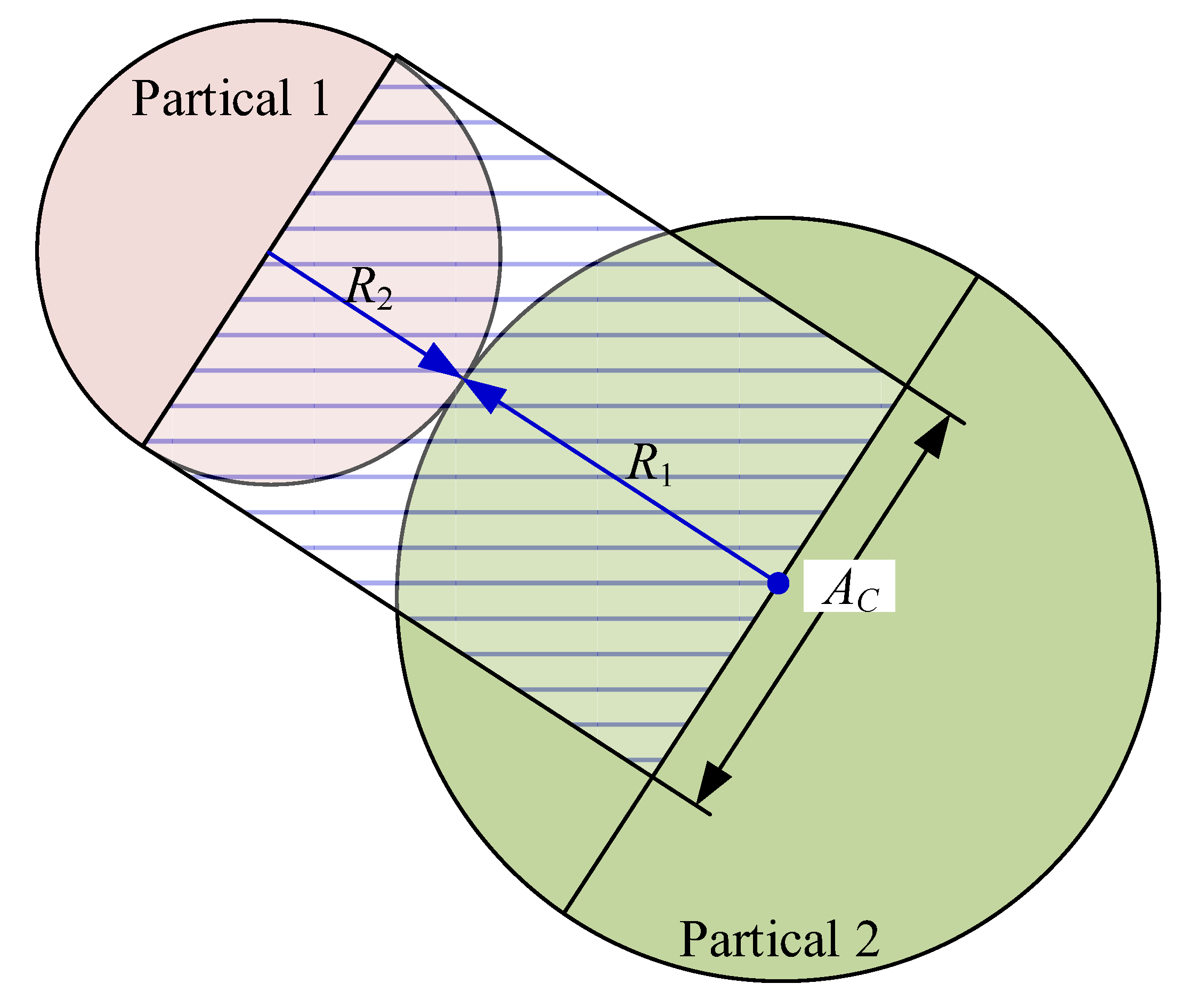
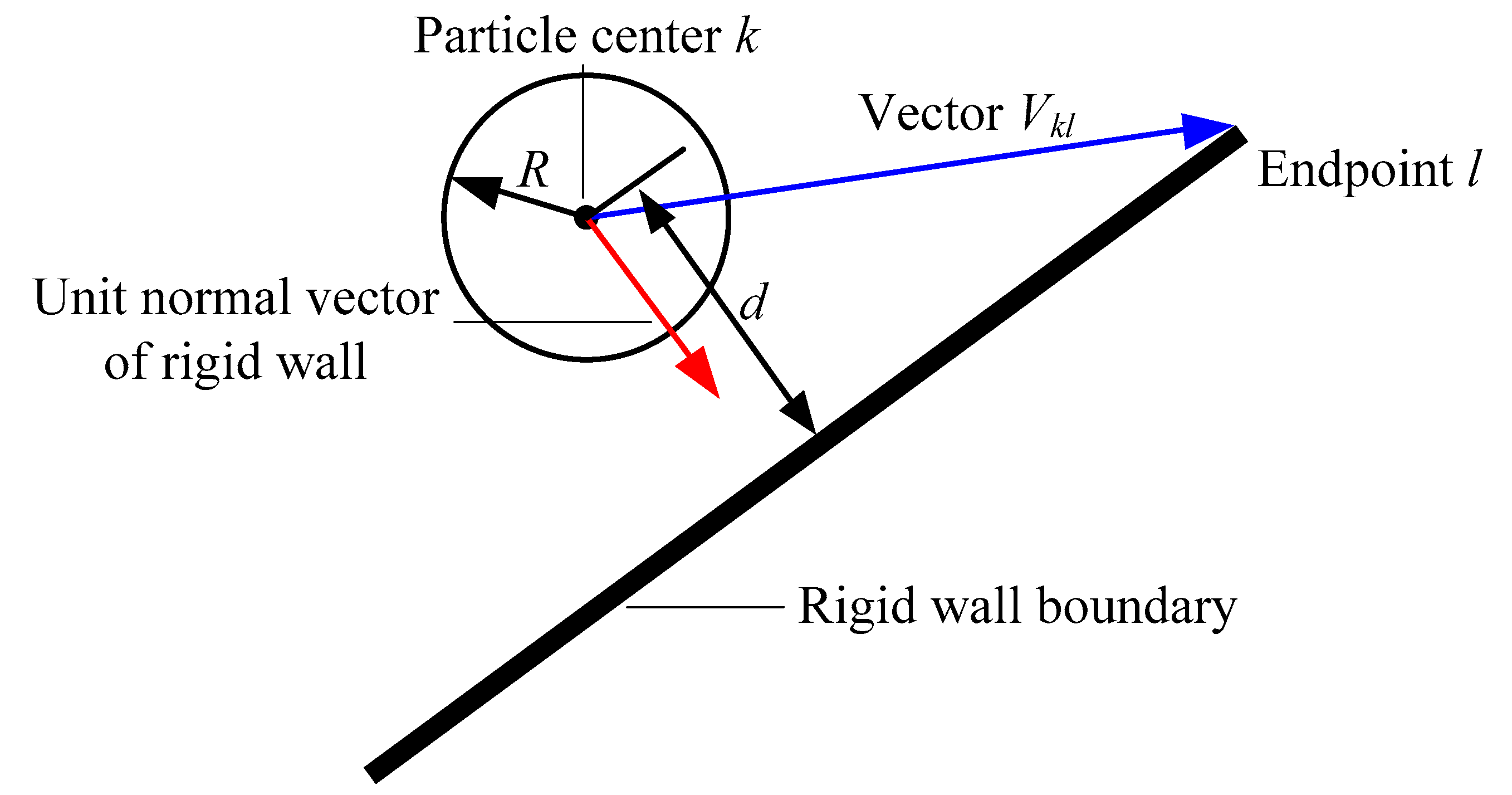
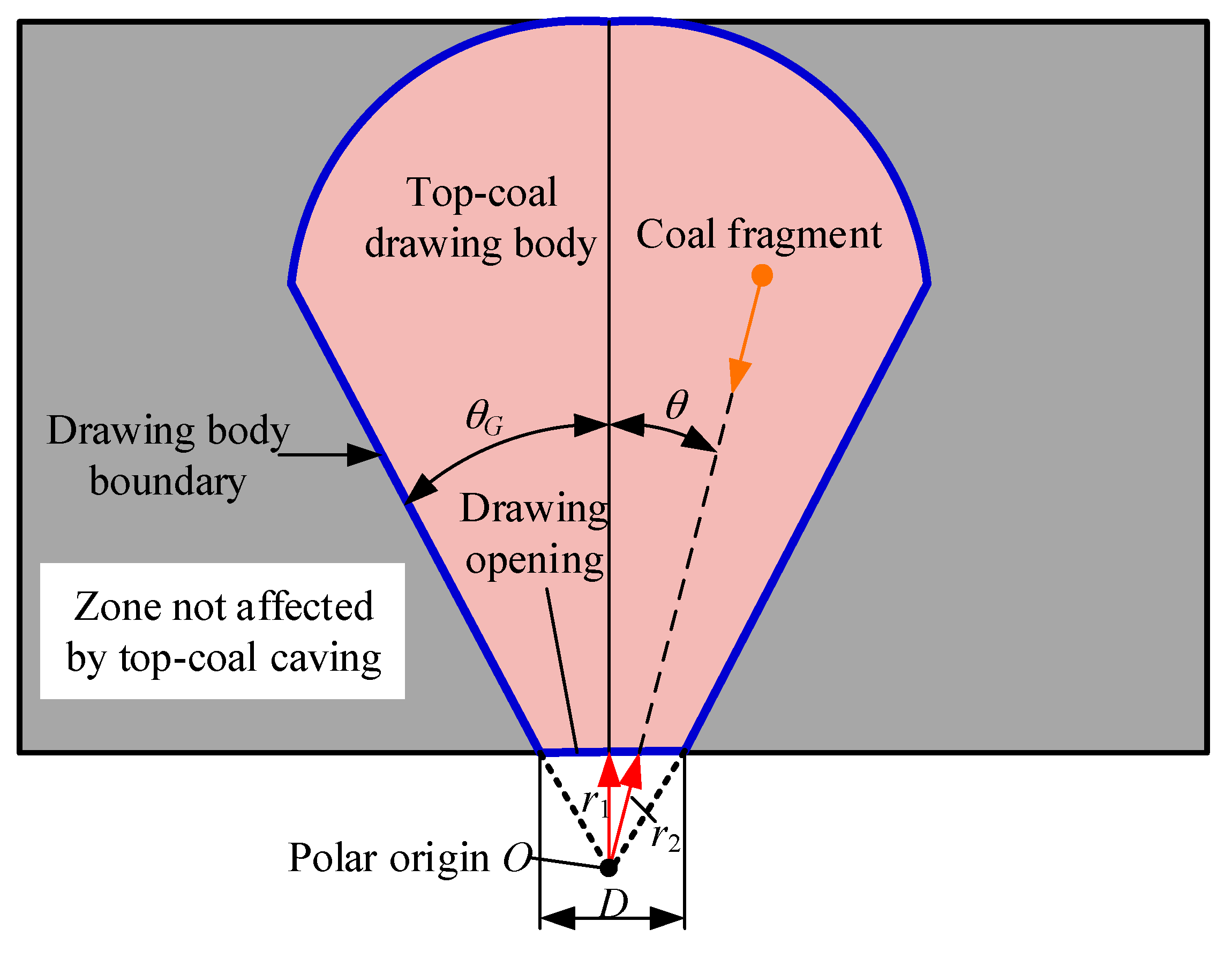
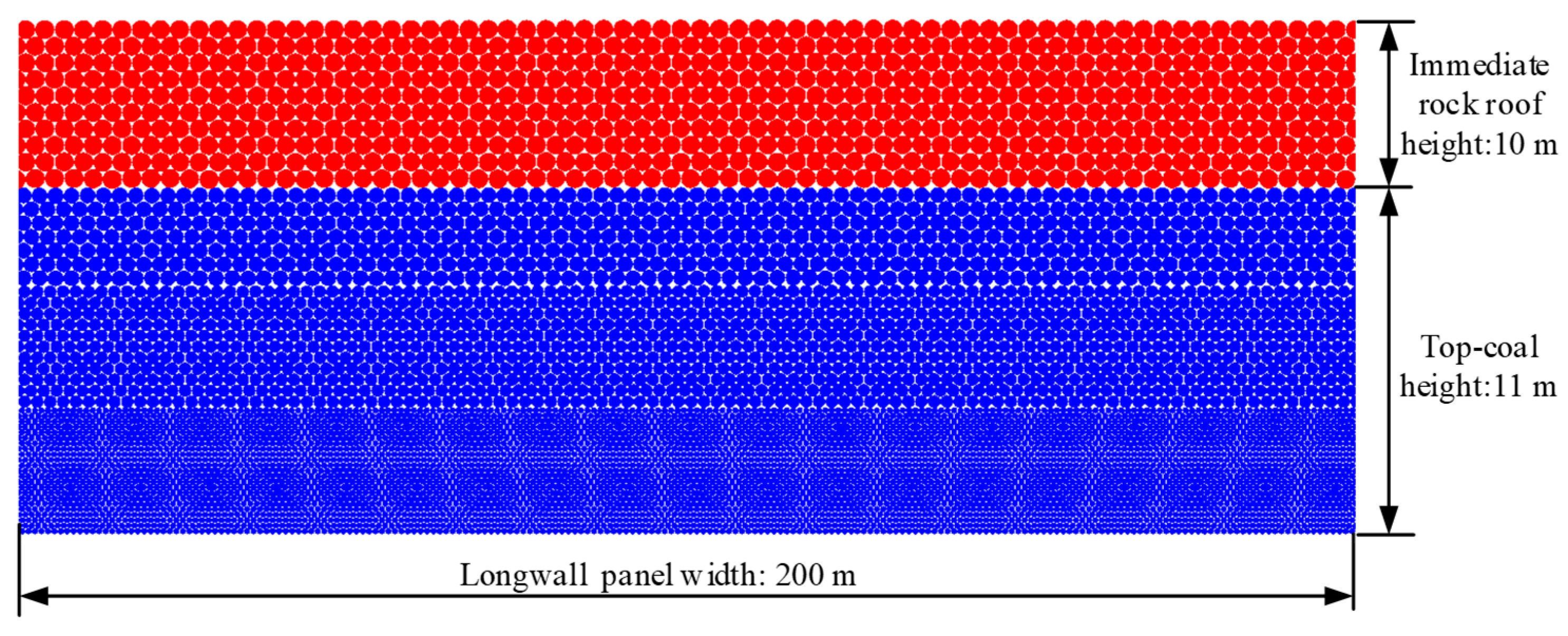
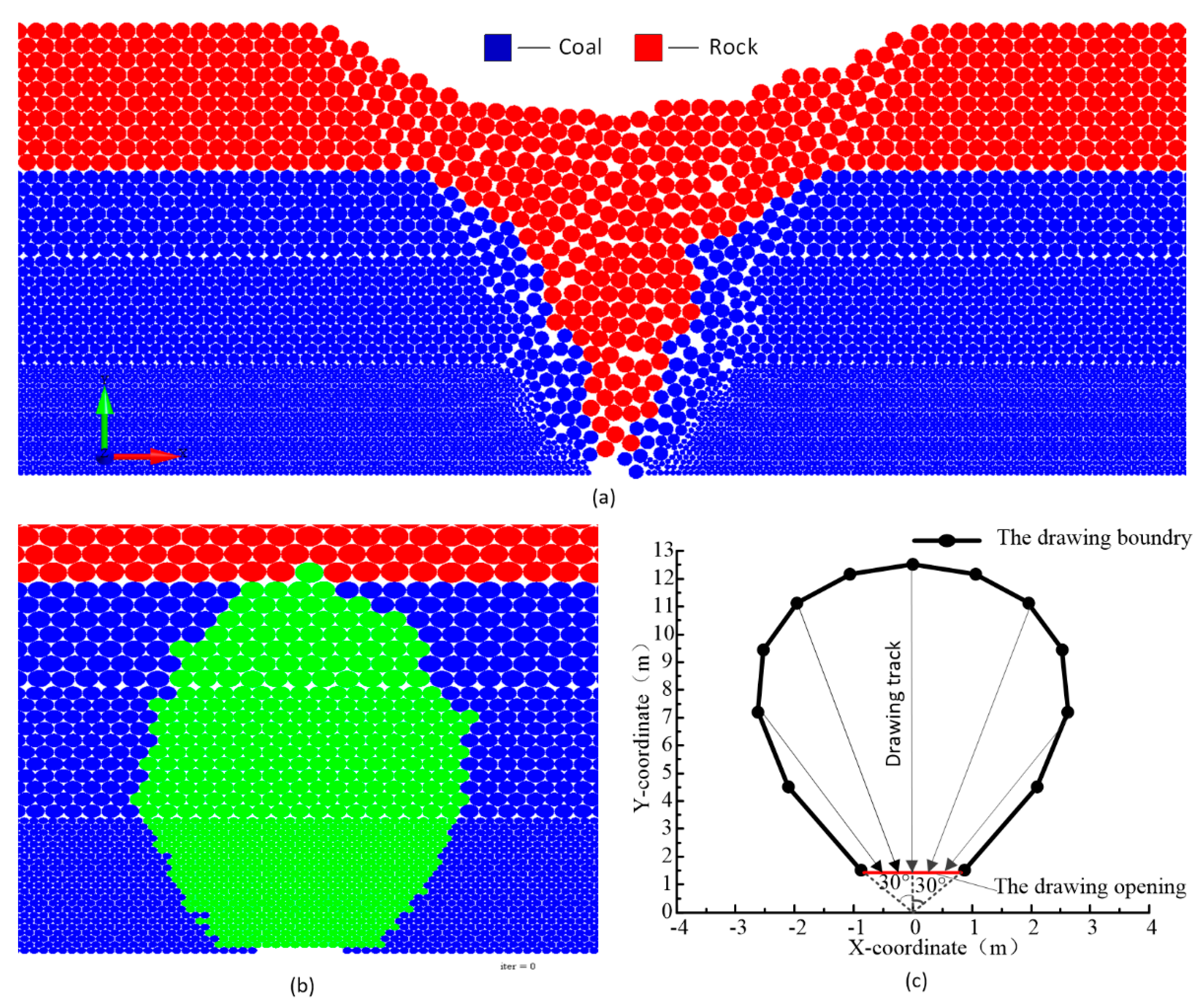
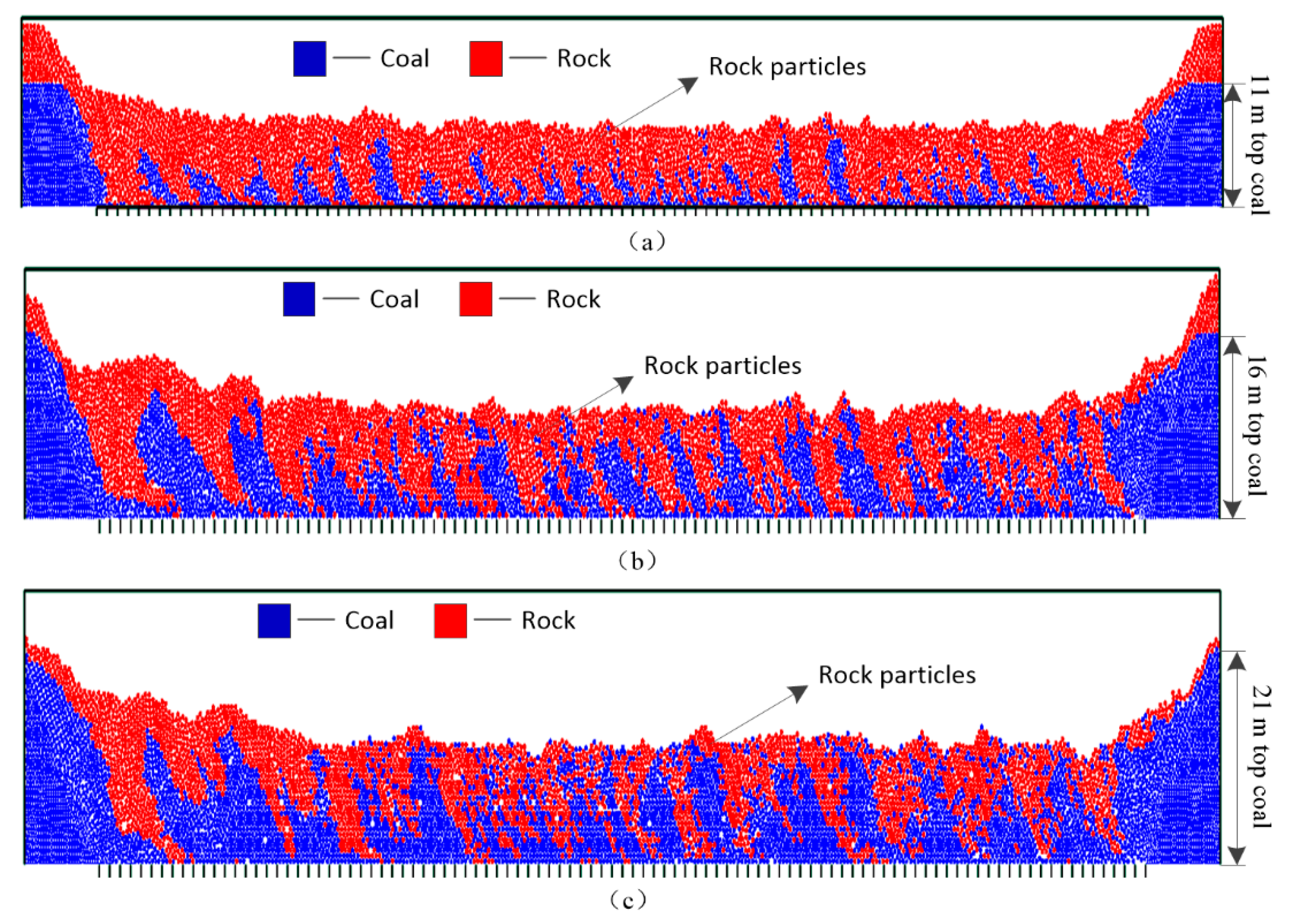
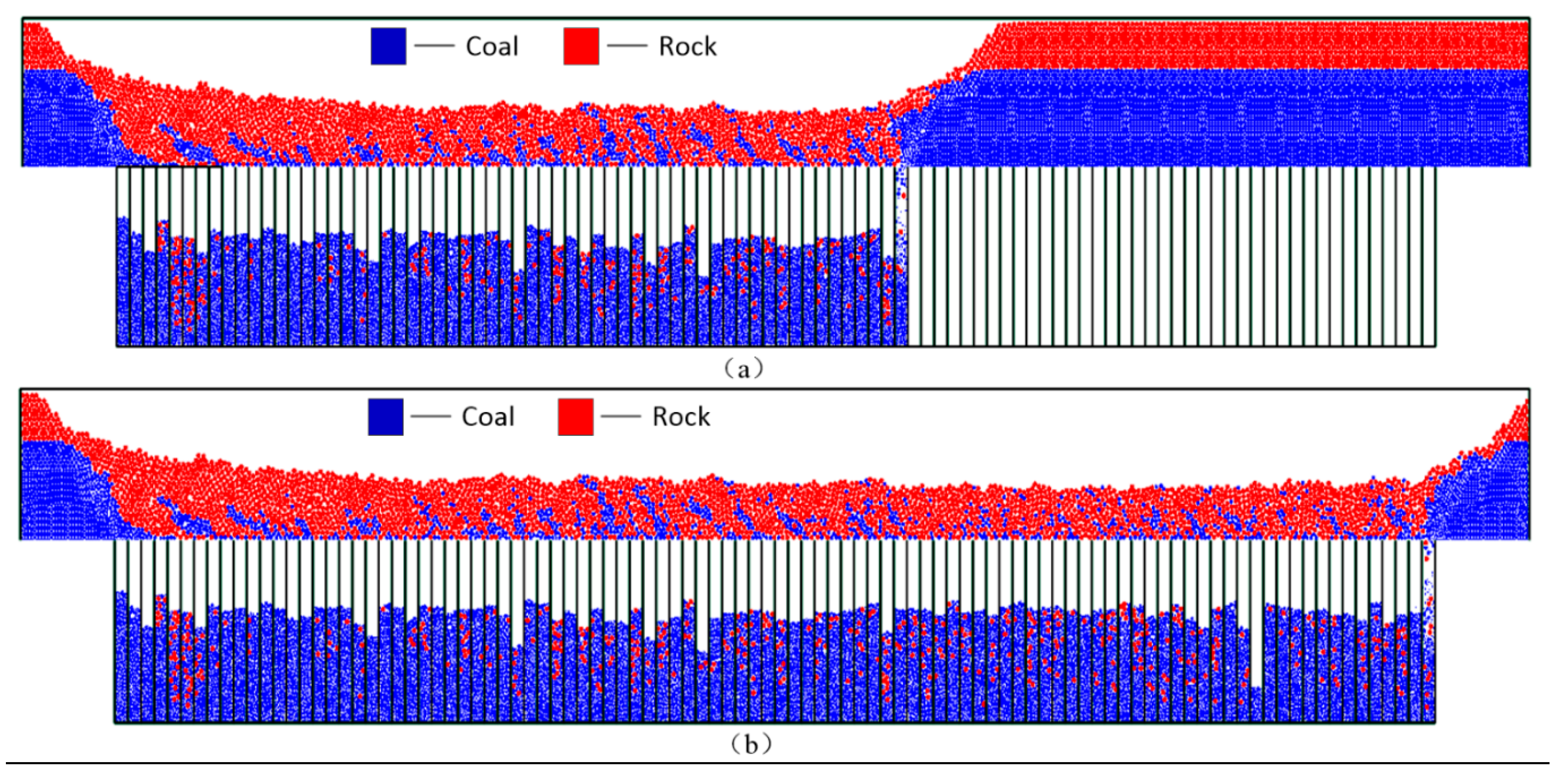
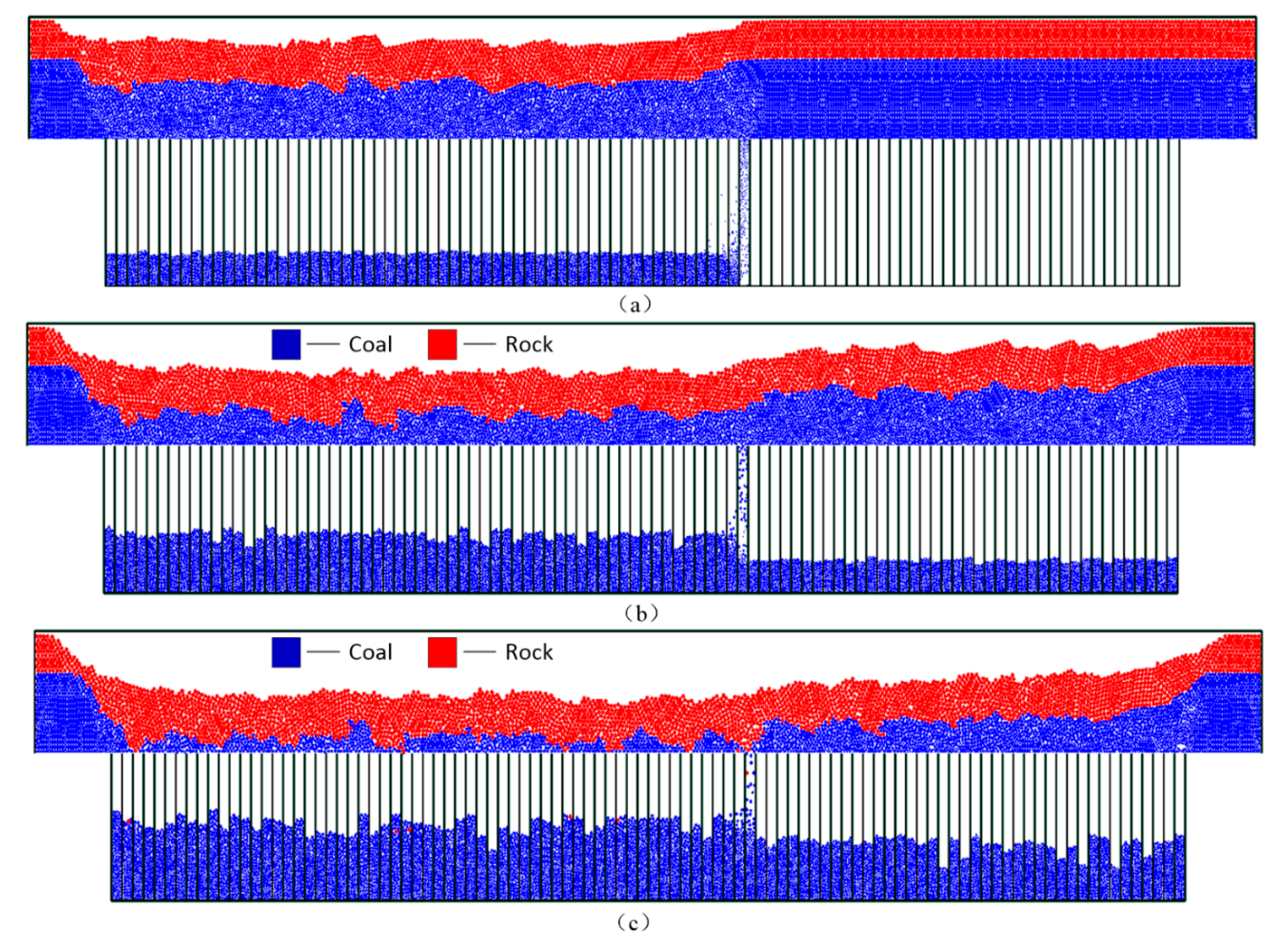
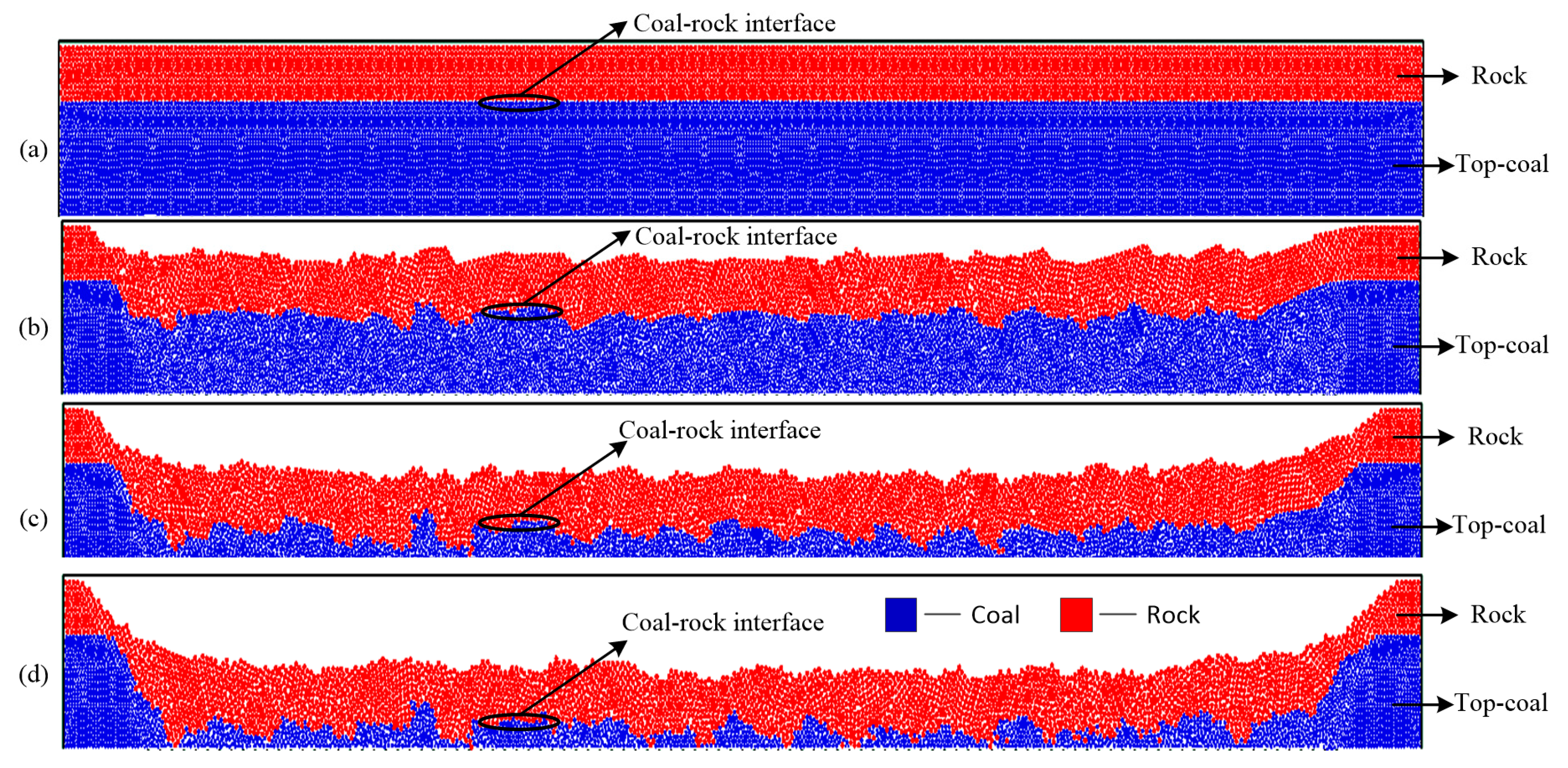
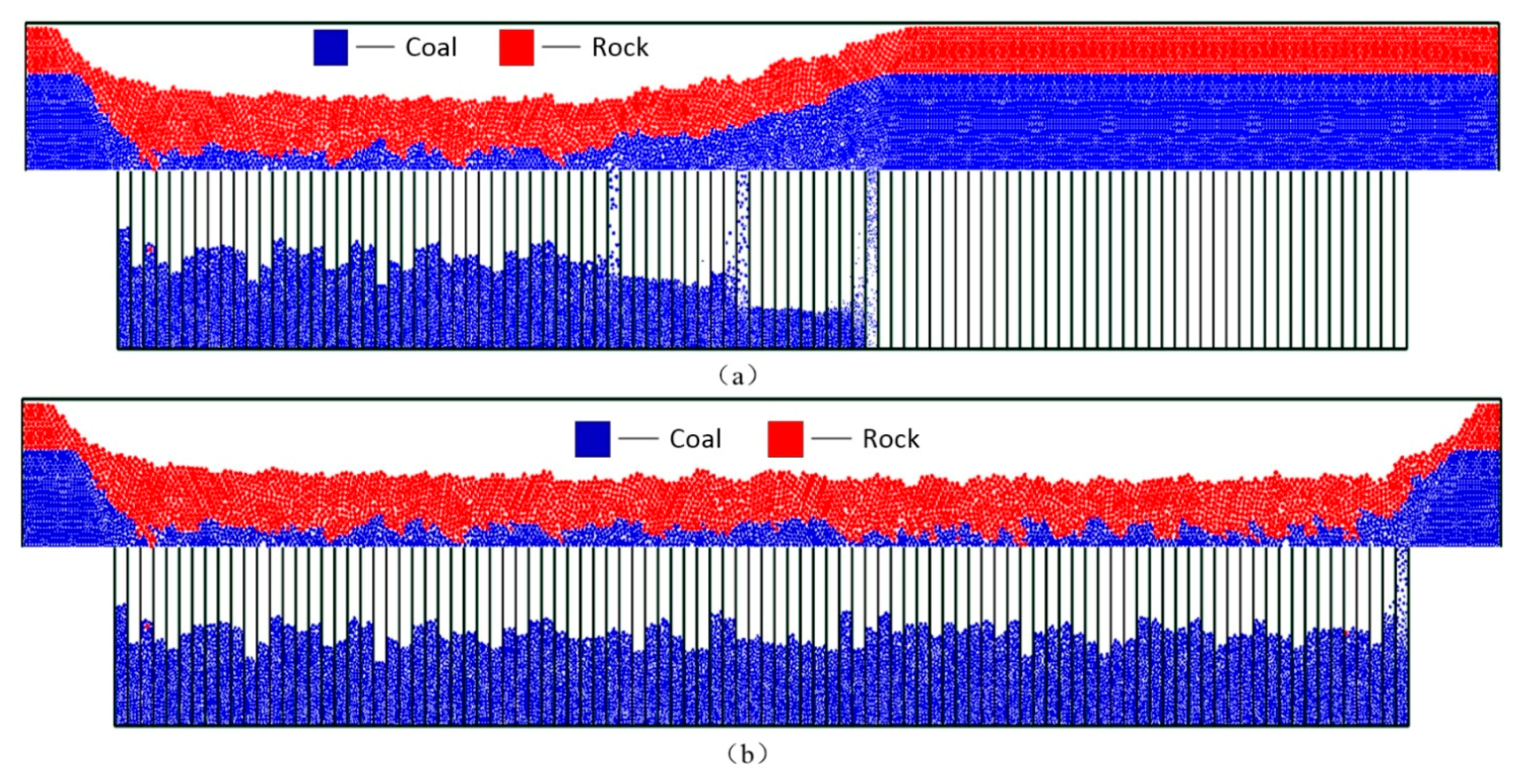
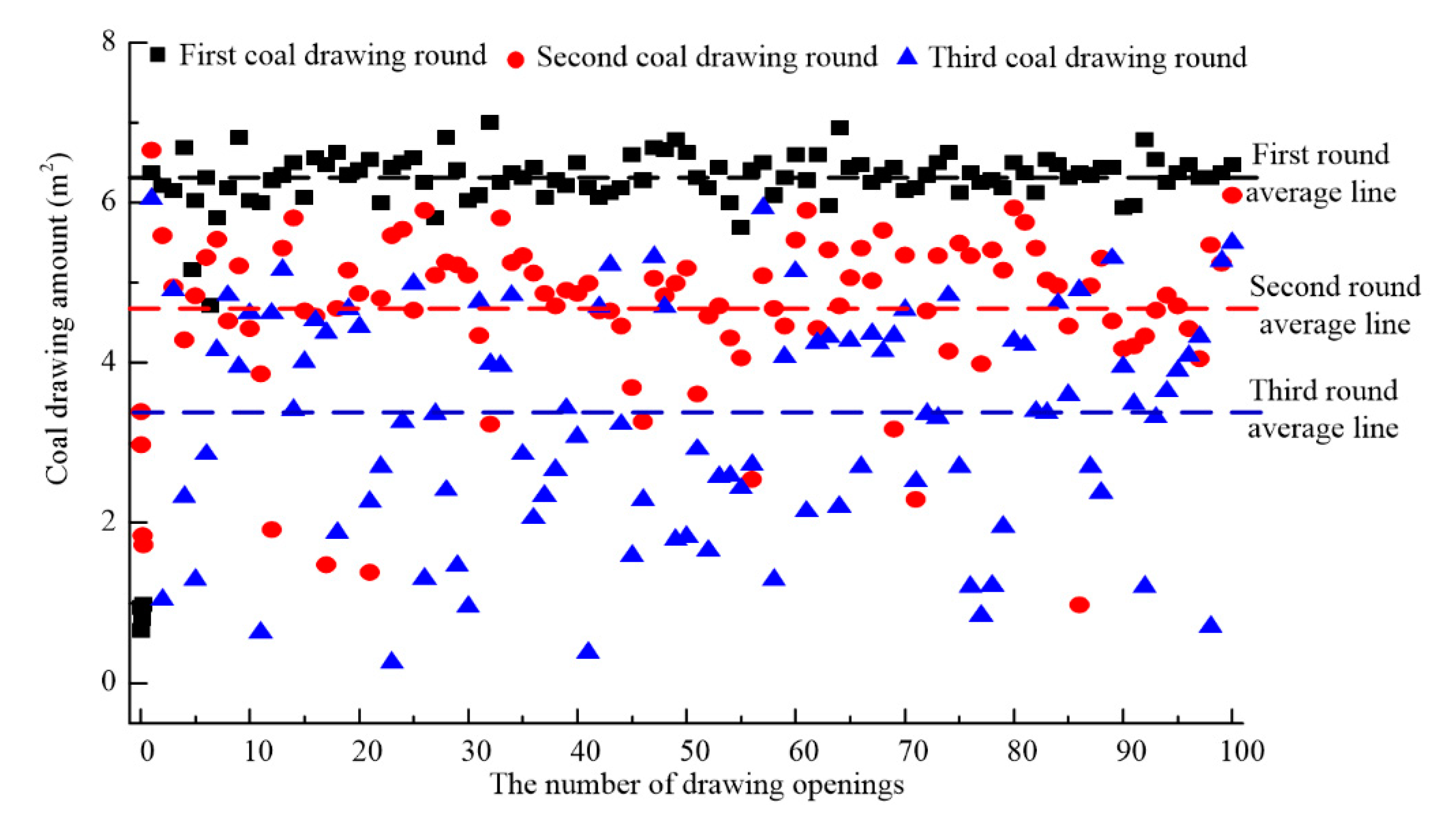
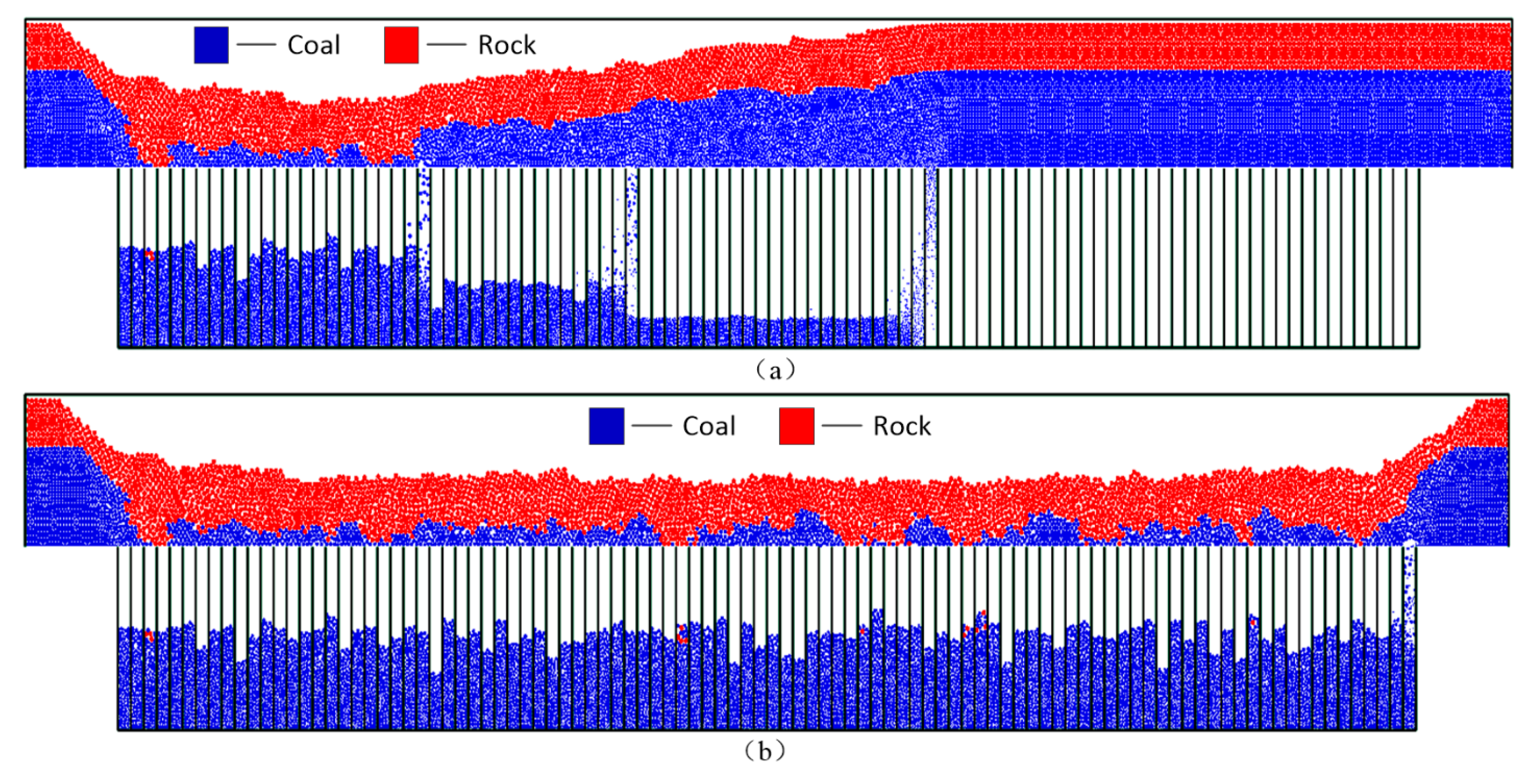
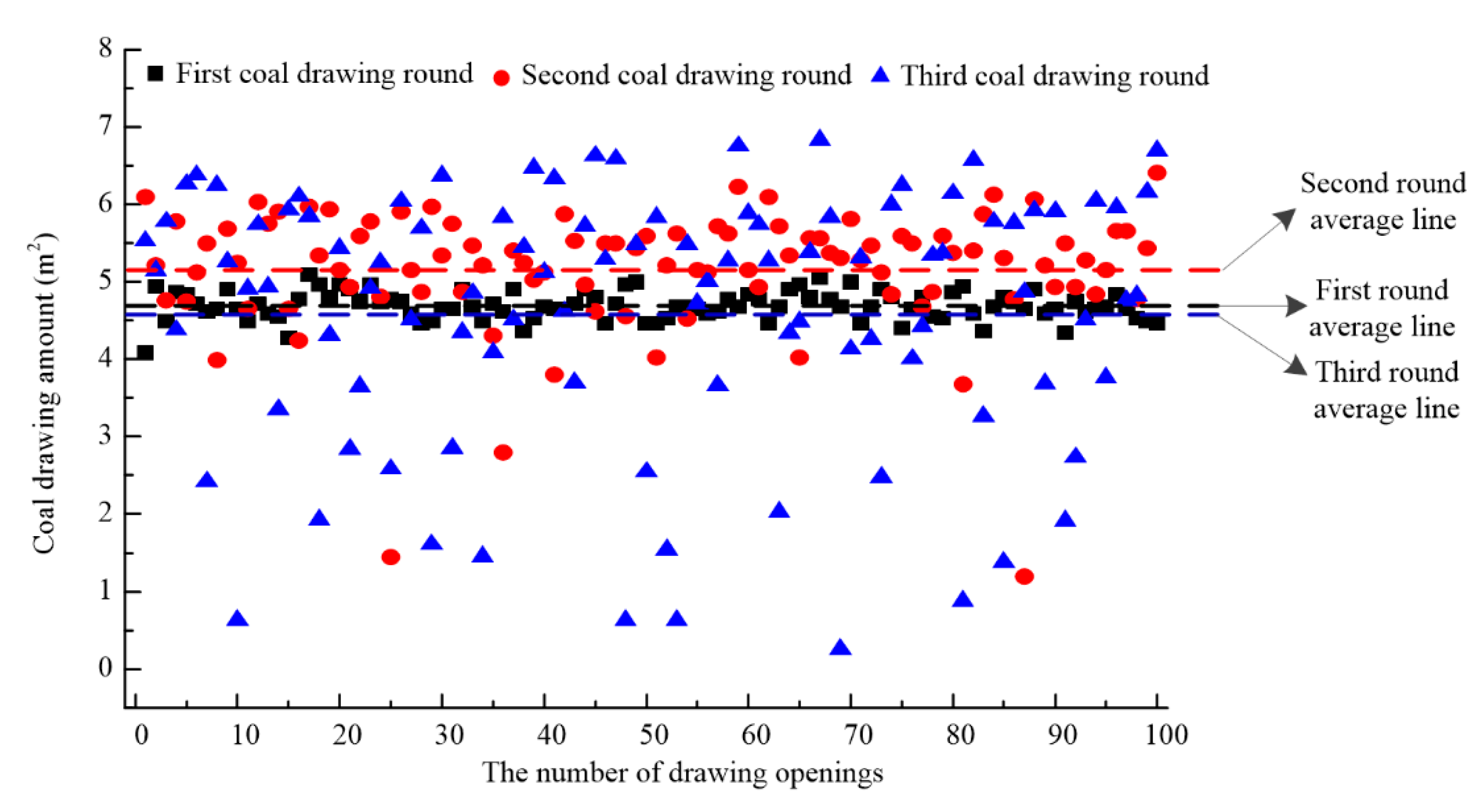
| Rock Layer Type | Density (kg/m3) | Elastic Modulus (Pa) | Poisson’s Ratio | Tensile Strength (Pa) | Cohesion (Pa) | Internal Friction (°) |
|---|---|---|---|---|---|---|
| Coal Seams | 1373 | 2 × 108 | 0.29 | 0 | 0 | 44.82 |
| Immediate Roof | 2542 | 4 × 108 | 0.23 | 0 | 0 | 33.6 |
| Top-Coal Thickness | Total Coal Amount (m2) | Drawn Top-Coal Amount (m2) | Top-Coal Recovery Rate (%) | Effective Thickness of Coal Drawing (m) |
|---|---|---|---|---|
| 11 m thick top-coal | 1839.9 | 1500.5 | 81.6 | 8.01 |
| 16 m thick top-coal | 2727 | 1990 | 72.97 | 10.63 |
| 21 m thick top-coal | 3605 | 2481 | 68.8 | 13.25 |
| 100 Drawing Openings | 11 m Thick Top-Coal | 16 m Thick Top-Coal | 21 m Thick Top-Coal |
|---|---|---|---|
| Drawn top-coal amount average (m2) | 15.01 | 19.86 | 23.57 |
| Drawn top-coal amount variance (m4) | 67.69 | 135.42 | 172.92 |
| Top-Coal Caving Technology | Total Coal Amount | Drawn Top-Coal Amount (m2) | Rock Drawing Amount (m2) | Top-Coal Recovery Rate (%) | Rock Mixed Rate (%) | Drawn Top-Coal Amount Variance |
|---|---|---|---|---|---|---|
| Automated coal caving | 1839.9 m2 | 1538.78 | 125.1 | 83.7 | 7.52 | 3.35 |
| Traditional coal caving | 941.6 m2 | 1500.5 | 0 | 81.6 | 0 | 67.69 |
| Top-Coal Caving Technology | Total Coal Amount (m2) | Drawn Top-Coal Amount (m2) | Rock Drawing Amount (m2) | Top-Coal Recovery Rate (%) | Rock Mixed Rate (%) |
|---|---|---|---|---|---|
| Equal time in every round | 1839.9 m2 | 1437.3 | 0.57 | 78.08 | 0.04 |
| Unequal time in every round | 941.6 m2 | 1448.34 | 3.96 | 78.61 | 0.27 |
© 2020 by the authors. Licensee MDPI, Basel, Switzerland. This article is an open access article distributed under the terms and conditions of the Creative Commons Attribution (CC BY) license (http://creativecommons.org/licenses/by/4.0/).
Share and Cite
Zhang, Q.; Yuan, R.; Wang, S.; Li, D.; Li, H.; Zhang, X. Optimizing Simulation and Analysis of Automated Top-Coal Drawing Technique in Extra-Thick Coal Seams. Energies 2020, 13, 232. https://doi.org/10.3390/en13010232
Zhang Q, Yuan R, Wang S, Li D, Li H, Zhang X. Optimizing Simulation and Analysis of Automated Top-Coal Drawing Technique in Extra-Thick Coal Seams. Energies. 2020; 13(1):232. https://doi.org/10.3390/en13010232
Chicago/Turabian StyleZhang, Qunlei, Ruifu Yuan, Shen Wang, Dongyin Li, Huamin Li, and Xuhe Zhang. 2020. "Optimizing Simulation and Analysis of Automated Top-Coal Drawing Technique in Extra-Thick Coal Seams" Energies 13, no. 1: 232. https://doi.org/10.3390/en13010232
APA StyleZhang, Q., Yuan, R., Wang, S., Li, D., Li, H., & Zhang, X. (2020). Optimizing Simulation and Analysis of Automated Top-Coal Drawing Technique in Extra-Thick Coal Seams. Energies, 13(1), 232. https://doi.org/10.3390/en13010232





